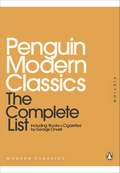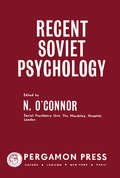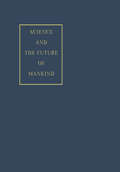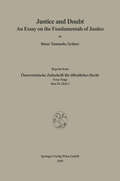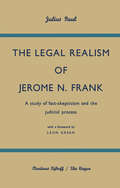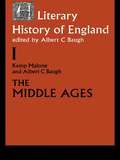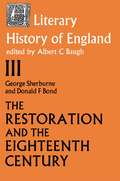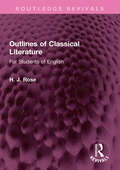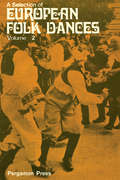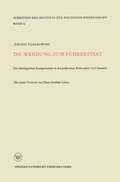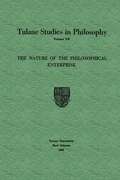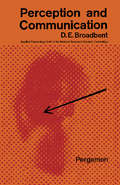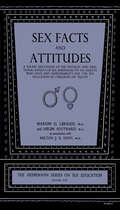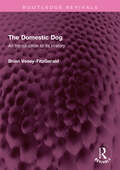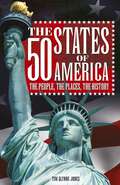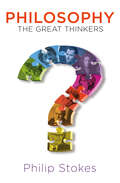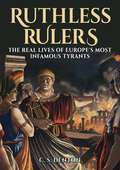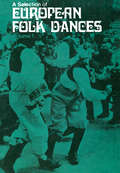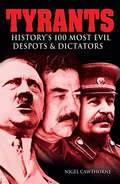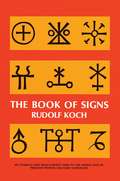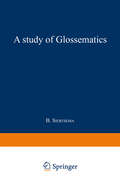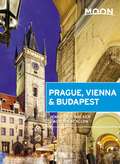- Table View
- List View
Penguin Modern Classics: The Complete List (Penguin Modern Classics)
by George Orwell'A classic is a book which has never exhausted all it has to say to its readers' from Why Read the Classics? by Italo CalvinoPenguin Modern Classics have been shaping the reading habits of generations since 1961. This 50th anniversary catalogue offers a complete list of all the titles in print across the Modern Classics list, from Chinua Achebe to Stefan Zweig via George Orwell and everything else in between. It also contains Italo Calvino's inspiring essay on what makes a classic a classic.
Recent Soviet Psychology
by N. O'ConnorRecent Soviet Psychology attempts to discuss previous approaches to Russian psychological literature on the part of English-speaking specialists, Russian attitudes to their own psychology, and the fields of interest of Russian psychology as represented in this compendium. This collection is divided into three sections. The main themes covered by these sections are physiology, speech, and education. In the section dealing with physiology, topics such as the typological properties and psychological manifestations of the nervous system are examined. Other topics in this section include conditioned reflex, sense of touch, image in touch, sensitivity, and sensory memory. The last two sections are devoted to discussing voluntary movements; study and investigation of speech, speech problems, and thought; and learning. This text will be invaluable to those interested in Soviet psychology, as well as to psychology students and experts.
The Legal Realism of Jerome N. Frank: A Study of Fact-Skepticism and the Judicial Process
by Julius PaulBetween the Levite at the gate and the judicial systems of our day is a long journey in courthouse government, but its basic structure remains the same - law, judge and process. Of the three, process is the most unstable - procedure and facts. Of the two, facts are the most intractable. While most of the law in books may seem to center about abstract theories, doctrines, princi ples, and rules, the truth is that most of it is designed in some way to escape the painful examination of the facts which bring parties in a particular case to court. Frequently the emphasis is on the rule of law as it is with respect to the negotiable instru ment which forbids inquiry behind its face; sometimes the empha sis is on men as in the case of the wide discretion given a judge or administrator; sometimes on the process, as in pleading to a refined issue, summary judgment, pre-trial conference, or jury trial designed to impose the dirty work of fact finding on laymen. The minds of the men of law never cease to labor at im proving process in the hope that some less painful, more trustworthy and if possible automatic method can be found to lay open or force litigants to disclose what lies inside their quarrel, so that law can be administered with dispatch and de cisiveness in the hope that truth and justice will be served.
A Literary History of England: The Middle Ages (to #1500)
by Albert C. Baugh Kemp MaloneThe paperback edition, in four volumes, of this standard work will make it readily available to students. The scope of the work makes it valuable as a work of reference, connecting one period with another and placing each author clearly in the setting of his time. Reviewing the first edition, The Times Literary Supplement commented: ‘in inclusiveness and in judgment it has few rivals of its kind’. This first volume covers The Middle Ages (to 1500) in two sections: The Old English Period (to 1100) by Kemp Malone (John Hopkins University), and The Middle English Period (1100-1500) by Albert C. Baugh (University of Pennsylvania).
The Literary History of England: Vol 3: The Restoration and Eighteenth Century (1660-1789)
by Donald F. Bond G. SherburnThe paperback edition, in four volumes, of this standard work will make it readily available to students. The scope of the work makes it valuable as a work of reference, connecting one period with another and placing each author clearly in the setting of his time. Reviewing the first edition, The Times Literary Supplement commented: ‘in inclusiveness and in judgment it has few rivals of its kind’. This third volume covers the Restoration and the Eighteenth Century (1660-1789) and is co-authored by George Sherburn and Donald F. Bond (both at the University of Chicago).
The Literary History of England: Vol 3: The Restoration and Eighteenth Century (1660-1789)
by George Sherburn and Donald F. BondThe paperback edition, in four volumes, of this standard work will make it readily available to students. The scope of the work makes it valuable as a work of reference, connecting one period with another and placing each author clearly in the setting of his time. Reviewing the first edition, The Times Literary Supplement commented: ‘in inclusiveness and in judgment it has few rivals of its kind’. This third volume covers the Restoration and the Eighteenth Century (1660-1789) and is co-authored by George Sherburn and Donald F. Bond (both at the University of Chicago).
Outlines of Classical Literature: For Students of English (Routledge Revivals)
by H. J. RoseFirst published in 1959, Outlines of Classical Literature is a guide for students of English literature who too often come to this difficult and complex subject with little or no knowledge of one of its principal sources. It therefore does not attempt to give a complete account of the Greek and Roman writers, but tries instead to deal with those whose influences, direct or indirect, can be clearly traced in medieval and later authors. The ancients are taken in their chronological order, though this is not necessarily the order in which they became known to, or influenced the Christian World; but to follow the latter would be too confusing. The book should be of interest to the undergraduate, the general reader and to the literary critic desirous of displaying classical erudition.
Outlines of Classical Literature: For Students of English (Routledge Revivals)
by H. J. RoseFirst published in 1959, Outlines of Classical Literature is a guide for students of English literature who too often come to this difficult and complex subject with little or no knowledge of one of its principal sources. It therefore does not attempt to give a complete account of the Greek and Roman writers, but tries instead to deal with those whose influences, direct or indirect, can be clearly traced in medieval and later authors. The ancients are taken in their chronological order, though this is not necessarily the order in which they became known to, or influenced the Christian World; but to follow the latter would be too confusing. The book should be of interest to the undergraduate, the general reader and to the literary critic desirous of displaying classical erudition.
A Selection of European Folk Dances: Volume 2
by Sam StuartA Selection of European Folk Dances, Volume 2 is a selection of folk dances from various European countries outside the British Isles, complete with dance sequence and music. These folk dances include Boarischer and Kreuzpolka from Austria; Kolomeyka from Carpathia; Schottische from Denmark; Viru Vals from Estonia; Bourrée Poursuite from France; Der Gamboliner Holzschuhtanz from Germany; Kokotek and Laura from Poland; Tarantella from Sicily; Fyrmanna Schottische from Sweden; and Hopak from Ukraine. This volume is comprised of 12 chapters and begins with a discussion on holds, which are of four types: peasant hold, open peasant hold, ballroom hold, and promenade hold. The next chapter explains the basic dance steps, from balance and chassé to step hop and waltz step. Subsequent chapters focus on European folk dances such as Boarischer and Kreuzpolka from Austria; Kolomeyka from Carpathia; Schottische from Denmark; Viru Vals from Estonia; Bourrée Poursuite from France; Der Gamboliner Holzschuhtanz from Germany; Kokotek and Laura from Poland; Tarantella from Sicily; Fyrmanna Schottische from Sweden; and Hopak from Ukraine. This book will be of particular value to dancers and folklorists.
Die Wendung zum Führerstaat: Ideologischen Komponenten in der Politischen Philosophie Carl Schmitts (Schriften des Instituts für politische Wissenschaft)
by Jürgen FijalkowskiThe Nature of the Philosophical Enterprise (Tulane Studies in Philosophy #7)
by Edward G. Ballard Richard L. Barber James K. Feibleman Harold N. Lee Paul Guerrant Morrison Andrew J. Reck Louise Nisbet Roberts Robert C. WhittemorePerception and Communication
by D.E. BroadbentPerception and Communication covers the significant advances in understanding the association between perception and communication.This book is composed of 12 chapters and starts with an overview of the value of auditory studies and the basic principles of perception and behavior theory. The next chapters deal with the theoretical interpretation of the experiments concerning selective listening to speech and some of the distinctive features of human verbal behavior. These topics are followed by discussions of the role of communication channels in listening; the effects of noise on behavior; the general nature of vigilance; some data on individual differences related to extraversion and decrement in non-vigilance tasks; and the nature of extinction. The closing chapters consider the problems of multi-channeling listening and the selective nature of learning. These chapters also provide a summary of principles of perception and communication.This book will prove useful to applied psychologists, behaviorists, and researchers.
Sex Facts and Attitudes: A Sound Discussion of the Physical and Emotional Aspects of Sex Addressed to All Adults Who Have Any Responsibility for the Sex Education of Children or Youth
by Marion O. Lerrigo Helen SouthardSex Facts and Attitudes is a five-chapter text that discusses the physical and emotional aspects of sex addressed to all adults who have any responsibility for the sex education of children or youth. Chapter 1 describes the interrelationship between sex education, attitude, love, and experience. Chapter 2 surveys the capacity or ""assets"" of adults to relate sex education to young ones. This chapter focuses on the influence of adult's emotion and experiences in giving sex advice. Chapter 3 discusses some basic facts about human reproduction, conception, pregnancy, and birth, while Chapter 4 describes the stages of physical growth and sexual development. Chapter 5 emphasizes the significance of open family communication in learning about sex. This book is of great value to experts and non-experts in the field of sex education.
The Domestic Dog: An Introduction to its History (Routledge Revivals)
by Brian Vesey-FitzGeraldFirst published in 1957, The Domestic Dog is the introduction to the history of man’s best friend, with special reference to Great Britain. After discussing the natural history of the Canidae and the possible sources of domestication, Mr. Vesey-FitzGerald surveys the career of the domestic dog from its beginnings in pre-historic times through to its present position as household companion and pet. He pays particular attention to the early literature of the dog and, even more particularly, to representations of the dog by the great artists of the world, since he believes that much of the history of the individual breeds can be traced in this way. He discusses the part played by the dog in war, in sport, and in the day-to-day occupations of man. He traces the development of breeding for Show and the growth of the Dog Show from the local rivalry of a few enthusiasts to a vast and complicated business, and considers the effect of breeding for Show on the dog as an animal. Finally, he discusses the most controversial subject, the classification of the domestic dog, and gives brief histories and descriptions of the various breeds. This book will be of interest to students of history, veterinary science as well as to anyone with a love for dogs.
The Domestic Dog: An Introduction to its History (Routledge Revivals)
by Brian Vesey-FitzGeraldFirst published in 1957, The Domestic Dog is the introduction to the history of man’s best friend, with special reference to Great Britain. After discussing the natural history of the Canidae and the possible sources of domestication, Mr. Vesey-FitzGerald surveys the career of the domestic dog from its beginnings in pre-historic times through to its present position as household companion and pet. He pays particular attention to the early literature of the dog and, even more particularly, to representations of the dog by the great artists of the world, since he believes that much of the history of the individual breeds can be traced in this way. He discusses the part played by the dog in war, in sport, and in the day-to-day occupations of man. He traces the development of breeding for Show and the growth of the Dog Show from the local rivalry of a few enthusiasts to a vast and complicated business, and considers the effect of breeding for Show on the dog as an animal. Finally, he discusses the most controversial subject, the classification of the domestic dog, and gives brief histories and descriptions of the various breeds. This book will be of interest to students of history, veterinary science as well as to anyone with a love for dogs.
The 50 States of America: The people, the places, the history
by Tim Glynne-JonesThe 50 States plus Washington DC that make up the USA all play their own unique part in the history and character of the nation. This book is an educational guide that teaches young readers about America's rich and varied history, geography and culture, and the people and places that stand out.
Philosophy: The Great Thinkers
by Philip Stokes'It is the mark of an educated mind to be able to entertain a thought without accepting it.' - Aristotle This illustrated guide showcases the major philosophers of the western tradition. Concise and informative, it provides an ideal introduction to their lives, ideas and the effect those ideas have had on the wider world. Both easy-to-use and a stimulating read, this book is an ideal reference for anybody interested in philosophy, and especially for those who want a clear, entertaining exposition of the ideas that shape the way we think. Key features: • A-Z format, covering the ideas of many of history's most influential thinkers, from Aristotle and Cicero to controversial contemporary philosophers such as Peter Singer and Jacques Derrida • At-a-glance summaries of the major works of each philosopher featured • Fully illustrated
Ruthless Rulers: The real lives of Europe's most infamous tyrants
by CS DentonThroughout history, all monarchs have lived with the same dichotomy of simultaneously being human and more than human.In our time, when monarchs seem little more than tourist curiosities and democracy is taken for granted, it is easy to forget just how much power pre-democratic rulers once wielded. The rulers and holders of political power in this book were all possessed of vast - in many cases, absolute, - power: power which was often exercised arbitrarily and unjustly.What unites the figures in this book is that they all, in one way or another, failed to live up to the extravagantly high hopes invested in them and, as a consequence, have been judged harshly by history.A few, such as George III, might have been remembered more kindly were it not for mental illness changing their status from that of hero to villain. Some, like Louis XVI, were unfairly transformed into monsters by hostile propaganda, while others, such as Pete the Great, have been both celebrated as heroes and denounced as tyrants, often in the same breath. Finally, there are hose rulers who, like Caligula or Ivan the Terrible, may well fully deserve their evil reputations.Ruthless Rulers is a study in how often rulers were carried away or overwhelmed by their exalted status, while a few were even driven over the edge into madness.
A Selection of European Folk Dances: Volume 1
by Sam StuartA Selection of European Folk Dances, Volume 1 is a selection of folk dances from various European countries outside the British Isles, complete with dance sequence and music. These folk dances include Die Woaf from Austria; Jooksu Polka from Estonia; Kleiner Schottisch from Germany; Hakke Toone from Holland; Tarantella from Italy; Fyrtur from Norway; Wrona Gapa from Poland; Karapyet from Russia; Fyrmannadans from Sweden; and Meitschi Putz-di from Switzerland. This volume is comprised of 12 chapters and begins with a discussion on holds, which are of three types: peasant hold, open peasant hold, and ballroom hold. The next chapter explains the basic dance steps, from balance and chassé to hambo, Mazurka step, polka step, and waltz step. Subsequent chapters focus on European folk dances such as Die Woaf from Austria; Jooksu Polka from Estonia; Kleiner Schottisch from Germany; Hakke Toone from Holland; Tarantella from Italy; Fyrtur from Norway; Wrona Gapa from Poland; Karapyet from Russia; Fyrmannadans from Sweden; and Meitschi Putz-di from Switzerland. This book will be of particular value to dancers and folklorists.
Tyrants: History's 100 Most Evil Despots & Dictators
by Nigel Cawthorne"I have committed many acts of cruelty and had an incalculable number of men killed, never knowing whether what I did was right. But I am indifferent to what people think of me."- Genghis KhanA spine-chilling chronicle of dictators and their crimes against humanity, Tyrants introduces the most bloodthirsty madmen - and women - ever to wield power over their unfortunate fellow human beings.From Herod the Great, persecutor of the infant Jesus, to Adolf Hitler, mass murderer and instigator of the most devastating war the world has ever known, this book examines history's most infamous despots and tells in vivid detail the story of the lives they led, their ruthless climb to the top and the destruction and sorrow they left in their wake.Unflinching in its coverage, Tyrants is a gripping and compelling portrait of the darker side of politics and power, revealing the strange and grisly stories behind the world's most infamous autocrats.
The Book of Signs
by Rudolf KochThis unusual collection of primitive and medieval symbols provides one of the most fertile single sources of decorative ideas available today. It is also a graphic history of the development of written communication and offers a singular insight into the psychology of the primitive mind. The Book of Signs contains 493 classified and documented illustrations, collected, drawn, and explained by the celebrated typographer Rudolf Koch. Divided into 14 different categories, it includes General Signs, The Cross, Monogram of Christ, Other Christian Signs, Monograms of Medieval Church and State Leaders, Stone Masons' Signs, The Four Elements, Astronomical Signs, Astrological Signs, Botanical Signs, Chemical Signs, House and Holding Marks, Miscellany, and Runes.
Moon Prague, Vienna & Budapest (Travel Guide)
by Jennifer D. Walker Auburn ScallonWhether you're sipping Czech beer with locals or exploring hilltop castles, get to know these fairytale cities with Moon Prague, Vienna & Budapest. Inside you'll find:Flexible itineraries for 1 to 5 days in Prague, Vienna, and Budapest that can be combined into a longer tripStrategic advice for foodies, art lovers, history buffs, and moreMust-see highlights and unique experiences: Enjoy classical music in Vienna, wander through labyrinthine Habsburg palaces, or soak in Budapest's thermal Széchenyi baths. Hike through the Vienna Woods or bike through the Wachau Valley, where ruined castles, vineyards, and rolling hills line the banks of the Danube. Admire the works of Klimt and Schiele in Vienna's glamorous galleries, take in the festive atmosphere at Prague's Christmas markets, and walk across the romantic Charles Bridge as the sun sets over the Vltava The best local flavors: Sip a Melange in a cozy booth of a classic Viennese coffeehouse, sample local wine at a Hungarian vineyard, and kick back with a pint of pilsner at one of Prague's beer gardens Ideas for side trips from each city, including Liberec, Danube Bend, Lake Balaton, and the Kutná Hore Bone ChurchHonest insight from Budapest local Jennifer Walker and Prague local Auburn ScallonFull-color photos and detailed maps throughoutBackground information on the landscape, history, and cultural customs of each cityHandy tools such as visa information, Hungarian, German, and Czech phrasebooks, and tips for traveling with children or as a seniorExperience the best of these three cities at your own pace with Moon Prague, Vienna & Budapest.Exploring more of Europe's top spots? Check out Moon Rome, Florence & Venice or Moon Barcelona & Madrid.
